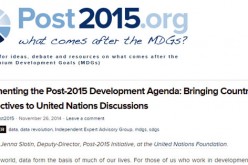‘Sustainability’ in the next development agenda: the case of energy access (Part 2)
This is the second post written by Nihit Goyal, Sahil Ali and Shweta Srinivasan, researchers at CSTEP. They have recently launched a new paper – Sustainable Access for All: Building sustainability into universal energy access – part of the Southern Voice Initiative.
In Part 1 of this two-part blog post, we argued that sustainability is not adequately captured in prominent proposals for a future goal on energy in the post-MDGs dialogue. In this post, we propose a framework to look beyond the current view on access and focus on Sustainable access.
Significance for the Global South
Sustainable access, i.e. energy access that can withstand internal and external disruptions, requires the energy system to possess stability (reliability), resilience, durability, and robustness. From a southern perspective, it is particularly important to include the notion of sustainable access for the following reasons:
i) Most developing countries are in the process of building extensive infrastructure to meet their rapidly rising energy demand. Since this requires large investments, the infrastructure built today will lock-in the energy system for the coming decades, even beyond 2050.
ii) It may be cheaper to build sustainability into the energy system now than to constantly redesign or repair it in response to failures, especially given the dependence of other systems (such as water, transport, and ICTs) on energy.
iii) The majority of the world’s most vulnerable populations reside in the Global South. As mentioned earlier, access plays a crucial role in increasing resilience, and this population could be affected by a lack of sustainable access when they most need it.
iv) Several developing countries lie in high disaster risk zones, yet their energy systems are even more vulnerable. They also take longer to respond to shocks due to lack of capacity – financial, organizational, technical, and so on.
Tracking sustainable access
To incorporate sustainability of access into the new MDGs/ SDGs, we propose a sustainability assessment framework that is adapted from the risk assessment framework. This framework permits the assessment of threats to sustainability through a quantitative or qualitative evaluation of the likelihood of disruptions, and their impact on access. This exercise includes the following steps:
i) Identify disruptions that may affect the system and, hence, access based on their temporality (such as short-term or long-term) and sphere of origin (such as economy, environment, fuel supply, national security, organization, politics, and technology). Any other classification could also be used to facilitate this identification.
ii) Qualitatively or quantitatively estimate the likelihood of occurrence of each disruption. If quantification is not possible or desirable, a simple categorisation of ‘High’, ‘Medium’, ‘Low’, ‘Negligible’ or ‘Unknown’ could be used.
iii) Examine the system’s vulnerability to each disruption based on sub-sectors exposed (supply, transmission & distribution, demand), regions affected, and communities impacted).
iv) Assess the impact of the disruption on each dimension of access in the tracking framework, in terms of its magnitude (i.e. how many people), extent (geographical area), and temporality (i.e. for how long). The assessor could choose to quantify the impact on access into a metric, or use a similar categorisation as mentioned above.
Figure 1: Sustainability Assessment Framework
 The likelihoods of disruptions in combination with the impact on access can then provide an indication of the sustainability of access (or lack thereof). In a qualitative assessment, sustainability of access can be gauged by locating disruptions on a sustainability matrix, as shown below. As sustainability increases, the overall threat to the system would reduce and disruptions would move towards the bottom left of the matrix. Similarly, quantitatively, the overall threat to sustainability could be gauged by aggregating the product of probabilities of disruptions and their impact on access. A smaller result would indicate a more sustainable system and vice versa. Thus, sustainability can be improved by lowering the likelihoods of disruptions, where possible, and by reducing their impact on access.
The likelihoods of disruptions in combination with the impact on access can then provide an indication of the sustainability of access (or lack thereof). In a qualitative assessment, sustainability of access can be gauged by locating disruptions on a sustainability matrix, as shown below. As sustainability increases, the overall threat to the system would reduce and disruptions would move towards the bottom left of the matrix. Similarly, quantitatively, the overall threat to sustainability could be gauged by aggregating the product of probabilities of disruptions and their impact on access. A smaller result would indicate a more sustainable system and vice versa. Thus, sustainability can be improved by lowering the likelihoods of disruptions, where possible, and by reducing their impact on access.
Figure 2: A matrix to assess threats to sustainability of access
 The adoption of this sustainability framework will complement the SE4All tracking framework by adding the crucial dimension of ‘sustainability’ to the ongoing dialogue on universal energy access. Further, through the use of the ‘Unknown’ category for likelihood of disruption or impact on access, this framework could help in detecting significant gaps in current knowledge, and highlight areas for further research. A systematic assessment could encourage planning and designing for greater sustainability, thus reducing the vulnerability of the energy system over time. Low hanging fruits, i.e. actions which have significant benefits for sustainable access at relatively small costs, could also be identified through such an assessment.
The adoption of this sustainability framework will complement the SE4All tracking framework by adding the crucial dimension of ‘sustainability’ to the ongoing dialogue on universal energy access. Further, through the use of the ‘Unknown’ category for likelihood of disruption or impact on access, this framework could help in detecting significant gaps in current knowledge, and highlight areas for further research. A systematic assessment could encourage planning and designing for greater sustainability, thus reducing the vulnerability of the energy system over time. Low hanging fruits, i.e. actions which have significant benefits for sustainable access at relatively small costs, could also be identified through such an assessment.
Such a notion of sustainability and a complimentary assessment framework could also extend to other goals in the post-MDGs dialogue. The choice of sustainability may involve trade-offs with the immediate pace of development. Furthermore, it is important to take a closer look at areas where the current tracking of the development target does not suitably gauge its longevity and where systems built over the coming few years will lock-in pathways. By creating the space to bring these challenges to the fore, the post-MDGs dialogue could facilitate capacity building, access to funding, and technology transfer to make the future we want more sustainable.
11,054 total views, 1 views today







Admiring the dedication you put innto your site and detailed information you present.
It’s awesome to come across a blog every once in a while that isn’t the same old rehashed information.
Wonderful read! I’ve saved your site and I’m adding your RSS feeds
to my Google account.